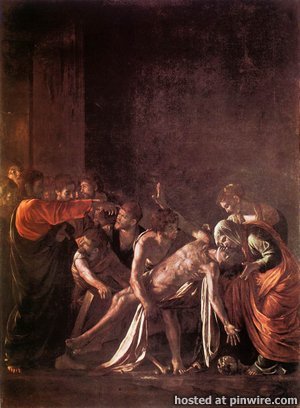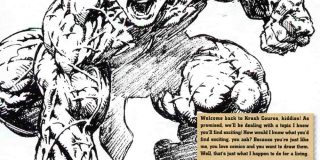Exile and death (1606-1610)
 The Denial of Saint Peter, c. 1610. Oil on canvas, 94 x 125 cm. Metropolitan Museum of Art, New York. In the chiaroscuro a woman points two fingers at Peter while a soldier points a third. Caravaggio tells the story of Peter denying Christ three times with this symbolism. |
Caravaggio led a tumultuous life. He was notorious for brawling, even in a time and place when such behavior was commonplace, and the transcripts of his police records and trial proceedings fill several pages. On 29 May 1606, he killed, possibly unintentionally, a young man named Ranuccio Tomassoni.[17] Previously his high-placed patrons had protected him from the consequences of his escapades, but this time they could do nothing. Caravaggio, outlawed, fled to Naples. There, outside the jurisdiction of the Roman authorities and protected by the Colonna family, the most famous painter in Rome became the most famous in Naples. His connections with the Colonnas led to a stream of important church commissions, including the Madonna of the Rosary, and The Seven Works of Mercy.
Despite his success in Naples, after only a few months in the city Caravaggio left for Malta, the headquarters of the Knights of Malta, presumably hoping that the patronage of Alof de Wignacourt, Grand Master of the Knights, could help him secure a pardon for Tomassoni’s death. De Wignacourt proved so impressed at having the famous artist as official painter to the Order that he inducted him as a knight, and the early biographer Bellori records that the artist was well pleased with his success. Major works from his Malta period include a huge Beheading of Saint John the Baptist (the only painting to which he put his signature) and a Portrait of Alof de Wignacourt and his Page, as well as portraits of other leading knights. Yet by late August of 1608 he was arrested and imprisoned. The circumstances surrounding this abrupt change of fortune have long been a matter of speculation, but recent investigation has revealed it to have been the result of yet another brawl, during which the door of a house was battered down and a knight seriously wounded.[18] By December he had been expelled from the Order “as a foul and rotten member.”[19]
 The Raising of Lazarus (1609), Museo Regionale Uffici, Messina. |
After only nine months in Sicily Caravaggio returned to Naples. According to his earliest biographer he was being pursued by enemies while in Sicily and felt it safest to place himself under the protection of the Colonnas until he could secure his pardon from the pope (now Paul V) and return to Rome.[20] In Naples he painted The Denial of Saint Peter, a final John the Baptist (Borghese), and, his last picture, The Martyrdom of Saint Ursula. His style continued to evolve – Saint Ursula is caught in a moment of highest action and drama, as the arrow fired by the king of the Huns strikes her in the breast, unlike earlier paintings which had all the immobility of the posed models. The brushwork was much freer and more impressionistic. Had Caravaggio lived, something new would have come.
In Naples an attempt was made on his life, by persons unknown. At first it was reported in Rome that the “famous artist” Caravaggio was dead, but then it was learned that he was alive, but seriously disfigured in the face. He painted a Salome with the Head of John the Baptist (Madrid), showing his own head on a platter, and sent it to de Wignacourt as a plea for forgiveness. Perhaps at this time he painted also a David with the Head of Goliath, showing the young David with a strangely sorrowful expression gazing on the wounded head of the giant, which is again Caravaggio’s. This painting he may have sent to the unscrupulous art-loving cardinal-nephew Scipione Borghese, who had the power to grant or withhold pardons.[21]
In the summer of 1610 he took a boat northwards to receive the pardon, which seemed imminent thanks to his powerful Roman friends. With him were three last paintings, gifts for Cardinal Scipione.[22] What happened next is the subject of much confusion and conjecture. The bare facts are that on 28 July an anonymous avviso (private newsletter) from Rome to the ducal court of Urbino reported that Caravaggio was dead. Three days later another avviso said that he had died of fever. These were the earliest, brief accounts of his death, which later underwent much elaboration. No body was found.[23] A poet friend of the artist later gave 18 July as the date of death, and a recent researcher claims to have discovered a death notice showing that the artist died on that day of a fever in Porto Ercole,[24] near Grosseto in Tuscany.



